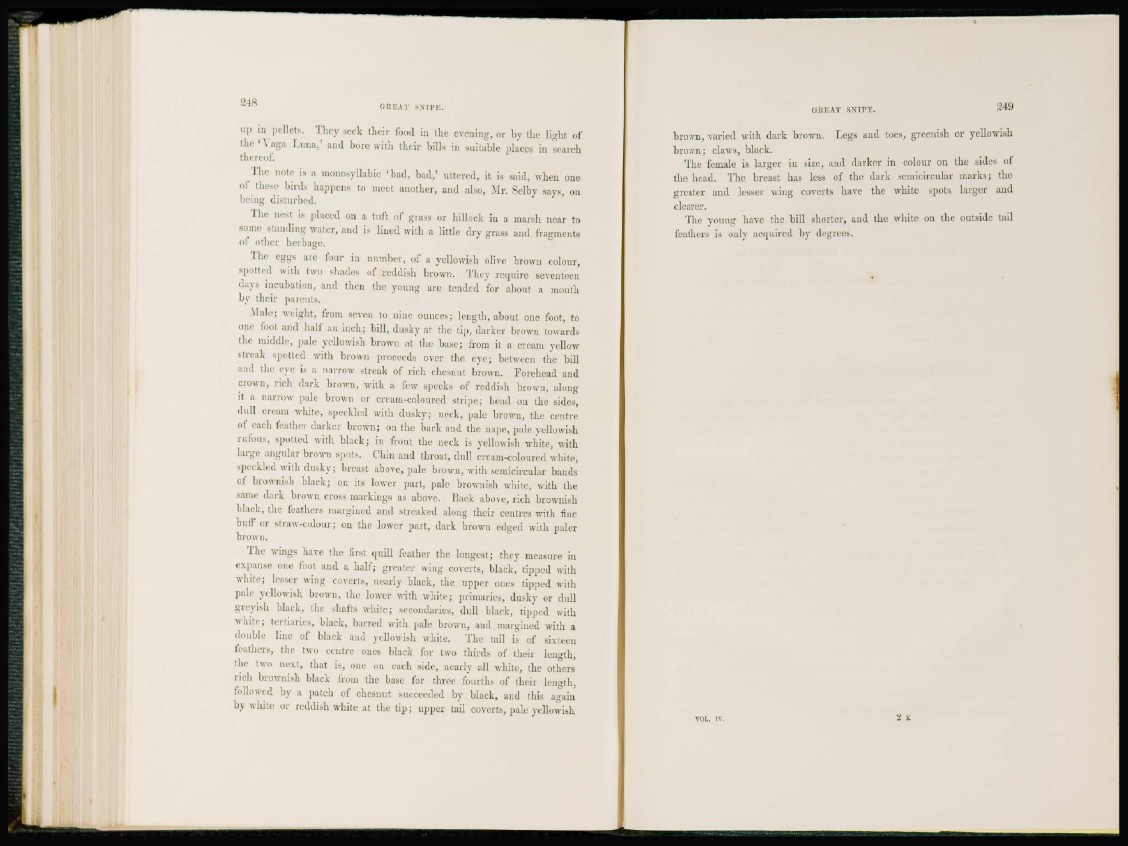
248 GREAT SNIPE.
up iii pellets. They seek their food in the evening, or by the light of
the ' \ aga Luna,' and bore with their bills in suitable places in search
thereof.
The note is a monosyllabic ' b a d , bad,' uttered, it is said, when one
of these birds happens to meet another, and also, Mr. Selby says, on
being disturbed.
The nest is placed on a tuft of grass or hillock in a marsh near to
some standing water, and is lined with a little dry grass and fragments
of other herbage.
The eggs arc four in number, of a yellowish olive brown colour,
spotted with two shades of reddish brown. They require seventeen
days incubation, and then the young are tended for about a month
by their parents.
Male; weight, from seven to nine ounces; length, about one foot, to
one foot and half an inch; bill, dusky at the tip, darker brown towards
the middle, pale yellowish brown at the base; from it a cream yellow
streak spotted with brown proceeds over the eye; between the bill
and the eye is a narrow streak of rich chesnut brown. Forehead and
crown, rich dark brown, with a few specks of reddish brown, along
it a narrow pale brown or cream-coloured stripe; head on the sides,
dull cream white, speckled with dusky; neck, pale brown, the centre
of each feather darker brown; on the back and the nape, pale yellowish
rufous, spotted with black: in front the1 neck is yellowish wdiitc, with
large angular brown spots. Chin and throat, dull cream-coloured white,
speckled with dusky; breast above, pale brown, with semicircular hands
of brownish black; on its lower part, pale brownish white, with the
same dark brown cross markings as above. Back above, rich brownish
black, the feathers margined and streaked along their centres with fine
buff or straw-colour; on the lower part, dark brown edged wdth paler
brown.
The wings have the first quill feather the longest; they measure in
expanse one foot and a half; greater wing coverts, black, tipped with
white; lesser wing coverts, nearly black, the upper ones tipped with
pale yellowish brown, the lower with white; primaries, dusky or dull
greyish black, the shafts wdiite; secondaries, dull black, tipped with
white; tertiaries, black, barred with pale brown, and margined with a
double line of black and yellowish wdiitc. The tail is of sixteen
feathers, the two centre ones black for two thirds of their length,
the two next, that is, one on each side, nearly all white, the others
rich brownish black from the base for three fourths of their length,
followed by a patch of chesnut succeeded by black, and this again
by white or reddish white at the t i p ; upper tail coverts, pale yellowish
GKEAT SNIPE. 249
brown, varied wdth dark brown. Legs and toes, greenish or yellowish
brown; claws, black.
The female is larger in size, and darker in colour on the sides of
the head. The breast has less of the dark semicircular marks; the
greater and lesser wing coverts have the white spots larger and
clearer.
The young have the bill shorter, and the white on the outside tail
feathers is only acquired by degrees.